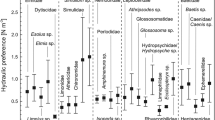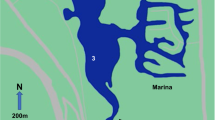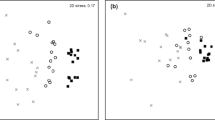Abstract
Laboratory experiments have been conducted on the effects of bioturbation by the amphipod Corophium volutator (Pallas) and the polychaete Nereis diversicolor (O.F. Müller) on the physical properties of estuarine muddy sand. Invertebrates and muddy sediment were collected from Langbank, Firth of Clyde, Scotland. Sediment columns were seeded with low, medium and high densities of invertebrates in single-and mixed-species experiments. Permeability decreased with increasing density of C. volutator, but increased with increasing density of N. diversicolor. Water content decreased with increasing density of both species. Shear strength increased with increasing density of both species, but more so with C. volutator than with N. diversicolor. Mixed-species effects on shear strength were additive, but some of the permeabilities were lower than predicted. Bivariate and multivariate correlation, and partial correlation analyses were applied to the data. Shear strength was negatively correlated with water content. The correlations between shear strength and permeability and between permeability and water content were affected differently by the two species. There were few partial correlations between the variables.
Similar content being viewed by others
Literature cited
Aller, R. C. (1982). The effects of macrobenthos on chemical properties of marine sediment and overlying water. In: McCall, P. L., Tevesv, M. J. S. (eds.) Animal-sediment relations: the biogenic alteration of sediments. Plenum Press, New York
Aller, R. C. (1983). The importance of the diffusive permeability of animal burrow linings in determining marine sediment chemistry. J. mar. Res. 41: 299–322
Anderson, J. G., Meadows, P. S. (1978). Microenvironments in marine sediments. Proc. R. Soc. Edinb. (Sect. B) 76: 1–16
Beard, D. C., Weyl, P. K. (1973). Influence of texture on porosity and permeability of unconsolidated sand. Bull. Am. Ass. Petrol. Geol. 57: 349–369
Capper, P. L., Cassic, W. F. (1976). The mechanics of engineering soils. Wiley, London
Cepède, C. (1914). Sur l'ethologique de Nereis (Hediste) diversicolor O. F. M. (à propos d'une critique faunistique du Prof. Caullery). Bull. Soc. zool. Fr. 39: 266–276
Crawford, G. I. (1937). A review of the amphipod genus Corophium with notes on the British species. J. mar. biol. Ass. U.K. 21: 589–630
Dales, R. P. (1951). An annual history of a population of Nereis diversicolor (O. F. Müller). Biol. Bull. mar. biol. Lab., Woods Hole 101: 131–137
Dillon, W. P., Zimmerman, H. B. (1970). Erosion by biological activity in two New England submarine canyons. J. sedim. Petrol. 40: 542–547
Eckmann, J. E., Nowell, A. R. M., Jumars, P. A. (1981). Sediment destabilisation by animal tubes. J. mar. Res. 39: 361–374
Fager, E. W. (1964). Marine sediments: effects of a tube-building polychaete. Science, N.Y. 143: 356–359
Fenchel, T. (1969). The ecology of marine microbenthos: (iv) structure and function of the benthic ecosystem, its chemical and physical factors, and the microfauna communities with special reference to the ciliated protozoa. Ophelia 6: 1–182
Foster-Smith, R. L. (1978). An analysis of water flow in tube-living animals. J. exp. mar. Biol. Ecol 34: 79–95
Gage, J. D., Geekie, A. D. (1973). Community structure of the benthos in Scottish sea-lochs. II. Spatial pattern. Mar. Biol 19: 41–53
Grant, J. (1981). Sediment transport and disturbance on an intertidal sandflat: infaunal distribution and recolonisation. Mar. Ecol. Prog. Ser. 6: 249–255
Gray, J. S. (1967). Substrate selection by the archiannelid Protodrilus hypoleucus Armenante. J. exp. mar. Biol. Ecol. 1: 47–54
Gray, J. S. (1974). Animal-sediment relationships. Oceanogr. mar. Biol. A. Rev. 12: 223–261
Green, J. (1968). The biology of estuarine animals. Sidgewick & Jackson, London
Hansbo, S. (1957). A new approach to the determination of the shear strength of clay by the fall-cone test. Proc. R. Swed. geotech. Inst. 14: 1–49
Hart, T. J. (1930). Preliminary notes on the bionomics of the amphipod Corophium volutator (Pallas). J. mar. biol. Ass. U.K. 16: 716–789
Hessler, R. R., Jumars, P. A. (1974). Abyssal community analysis from relicate box-corers in the central North Pacific. Deep-Sea Res. 21: 185–209
Katz, L. C. (1980). Effects of burrowing by the fidder crab, Ucapugnax Smith. Estuar. cstl mar. Sci. 11: 233–237
Koike, I., Mukai, H. (1983). Oxygen and inorganic nitrogen contents and fluxes in burrows of the shrimps Callianasa japonica and Upogebia major. Mar. Ecol. Prog. Ser. 12: 185–190
Lambe, T. W., Whitman, R. V. (1979). Soil mechanics. Standard edition, Wiley & Sons, New York
Lee, I. K., White, W., Ingles, O. G. (1983). Geotechnical engineering. Pitman, Boston
Luckenbach, M. W. (1986). Sediment stability around animal tubes: the roles of hydrodynamic processes and biotic activity. Limnol. Oceanogr. 31: 779–787
Meadows, P. S. (1964a). Experiments on substrate selection by Corophium volutator: films and bacteria on sand particles. J. exp. Biol. 41: 499–511
Meadows, P. S. (1964b). Experiments on substrate selection by Corophium volutator: depth selection and population density. J. exp. Biol. 41: 677–687
Meadows, P. S. (1986). Biological activity and seabed sediment structure. Nature, Lond. 323: p. 207
Meadows, P. S., Campbell, J. I. (1972a). Habitat selection by aquatic invertebrates. Adv. mar. Biol. 10: 271–382
Meadows, P. S., Campbell, J. I. (1972b). Habitat selection and animal distribution in the sea: the evolution of a concept. Proc. R. Soc. Edinb. (Sect. B) 73: 145–157
Meadows, P. S., Reid, A. (1966). The behaviour of Corophium volutator. J. Zool., Lond. 150: 387–399
Meadows, P. S., Tait, J. (1985). Bioturbation, geotechnics and microbiology at the sediment-water interface in deep sea sediments. Proc. 19th Eur. mar. Biol. Symp. 191–199. [Gibbs, P.E. (ed.). Cambridge University Press, Cambridge]
Meadows, P. S., Tufail, A. (1986). Bioturbation, microbial activity and sediment properties in an estuarine ecosystem. Proc. R. Soc. Edinb. (Sect. B) 90: 1–14
Neumann, A. C., Gebelein, C. D., Scoffin, T. P. (1970). The composition, structure, and erodibility of subtidal mats, Abaco, Bahamas. J. sedim. Petrol. 40: 274–297
Nowell, A. R. M., Jumars, P. A., Eckmann, J. E. (1981) Effects of biological activity on the entrainment of marine sediments. Mar. Geol. 42: 133–153
Powell, E. N. (1977). Particle size selection and sediment reworking in a funnel feeder, Leptosynapta tenuis (Holothuroides, Synaptidae). Int. Revue ges. Hydrobiol. 62: 385–408
Rhoads, D. C., Yingst, J. Y., Ullman, W. J. (1978). Seafloor stability in Central Long Island Sound: Part I. Temporal changes in erodibility of fine grained sediment. In: Wiley, M. L. (ed.). Estuarine interactions. Academic Press, New York
Rowe, G. T. (1974). The effect of the benthic fauna on the physical properties of deep sea sediments. In: Inderbitzen, A. L. (ed.), Deep sea sediments: physical and mechanical properties. Plenum, New York
Schafer, W. (1972). Ecology and paleoecology of marine environments. Oliver & Boyd, Edinburgh
Segerstrale, S. G. (1940). Zur Biologie des Amphipoden Corophium volutator nebst Angaben über die Entwicklung und Rückbildung der Oostegitenborsten bei dieser. Art. Commentat. biol. 7 (16): 1–40
Segerstrale, S. G. (1959). Synopsis of data on the crustaceans Gammarus locusta, Gammarus oceanicus, Pontoporeia affinis, and Corophium volutator (Amphipoda, Gammaridea). Commentat. biol. 20 (5): 1–23
Smith, R. I. (1955). Salinity variation in interstitial water at Kames Bay, Millport, with reference to the distribution of Nereis diversicolor. J. mar. biol. Ass. U.K. 34: 33–46
Spooner, G. M., Moore, H. B. (1940). The ecology of the Tamar estuary. II. An account of the macrofauna of the intertidal muds. J. mar. biol. Ass. U.K. 24: 283–330
Stock, J. H. (1952). Some notes on the taxonomy, the distribution and the ecology of four species of the amphipod genus Corophium (Crustacea: Malacostraca). Beaufortia 21: 1–10
Thorson, G. (1957). Bottom communities (sublittoral or shallow shelf). Mem. geol. Soc. Am. 67: 461–534
Trask, P. D., Rolston, J. W. (1950). Relation of strength of sediments to water content and grain size. Science, N.Y. 111: 666–667
Trevor, J. H. (1977). The burrowing of Nereis diversicolor O. F. Müller together with some observations on Arenicola marina (L.). (Annelida-Polychaeta). J. exp. mar. Biol. Ecol. 30: 129–145
Weaver, P. P. E., Schultheiss, P. J. (1983). Vertical open burrows in deep-sea sediments 2 m in length. Nature, Lond. 301: 329–331
Yingst, J. Y., Rhoads D. C. (1978). Seafloor stability in Central Long Island Sound, Part II. Biological interactions and their potential importance for sea floor erodibility. In: Wiley, M. L. (ed.). Estuarine Interactions. Academic Press, New York
Yong, R. N., Warkentin, B. (1966). Introduction to soil behaviour. Collier-MacMillan, London
Author information
Authors and Affiliations
Additional information
Communicated by J. Mauchline, Oban
Rights and permissions
About this article
Cite this article
Meadows, P.S., Tait, J. Modification of sediment permeability and shear strength by two burrowing invertebrates. Mar. Biol. 101, 75–82 (1989). https://doi.org/10.1007/BF00393480
Accepted:
Issue Date:
DOI: https://doi.org/10.1007/BF00393480




